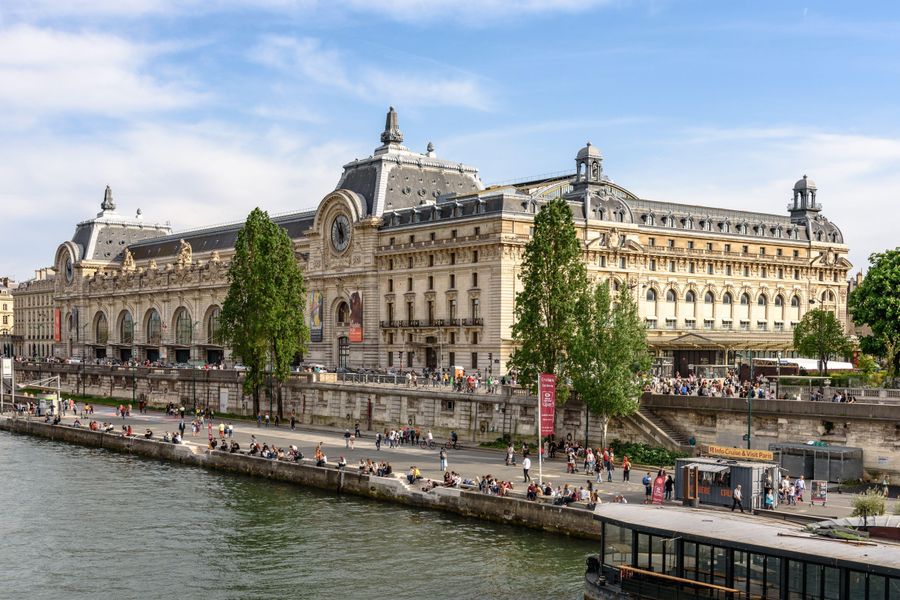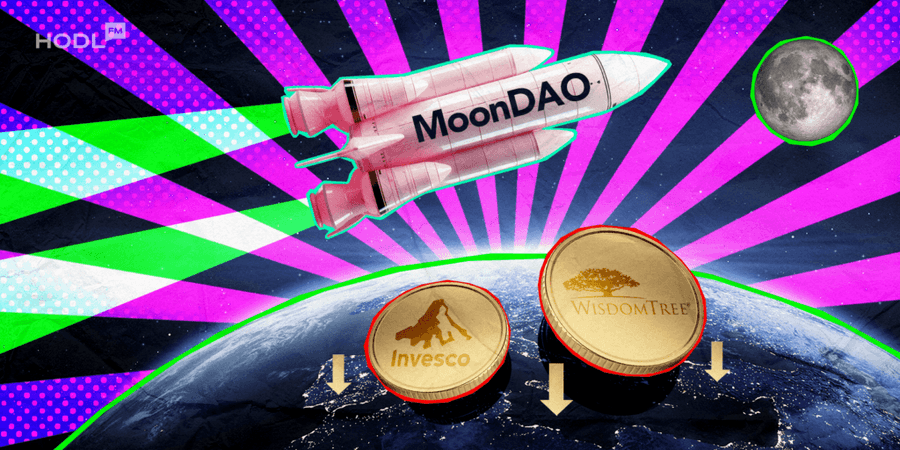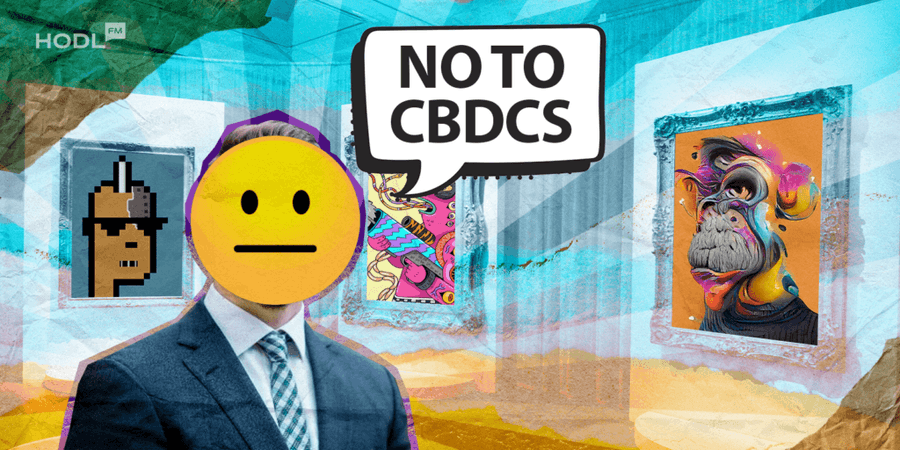This time, we’re not launching from Land, but straight from the Moon. Well, not literally today, but on the same day in 2030 when MoonDAO establishes a colony on Mars. From there, we’ll be watching American and European ETF funds fighting for clients, and lowering fees. Meanwhile, in the finest museums worldwide, blockchain exhibitions will be held in the best museums in the world, and Republicans will still be against CBDC. But for now, that’s the news from the current year over the past week, as you guessed it.
MoonDAO to the Moon, Literally
For the past two and some odd years, MoonDAO co-founder Pablo Moncada and his decentralized autonomous organization (DAO) have been on a mission to build a self-sustaining colony on the Moon.
They’ve set a deadline just shy of seven years. That’s the very ambitious goal of Moncada and MoonDAO, who rounded up a squad of 5000 enthusiasts in 2021.
Moncada sees the DAO as the answer to a decades-long problem – exploration is completely inaccessible to ordinary people. He’s convinced that his model could redefine space travel, and if all goes well, by 2030, we might just have people living on the Moon.
Space exploration is extremely “fenced in,” claims Moncada, dominated by state space programs or well-funded private companies. MoonDAO, also known as ‘the internet’s space program,’ here to flip the script and make regular people the financial backers of all space-related things. Traditionally, it’s been a tale of governments collecting cash through taxes and then sending a part of the national budget into the cosmos.
MoonDAO’s Authority in Space
Sure, the DAO might not have sent anyone to the Moon yet. Still, the co-founder proudly boasts they’ve already successfully sent folk to space – not the moon, but close enough. Last November, MoonDAO voted to launch Coby Cotton, the YouTube sensation from the Dude Perfect channel, into space aboard one of Jeff Bezos’ Blue Origin spaceships.
According to Moncada, the most crucial thing MoonDAO brings to the table is a fundamental shift in how organizations fundraise for exciting new cosmic endeavors.
Leader’s Doubts
However, Moncada admits that it’s actually quite “unlikely” to have people on the Moon by 2030, though that didn’t stop him and his DAO from trying.
No stranger to lofty goals, Moncada worked as a developer for “ConstitutionDAO”, a group that raised around 49 million dollars in an attempt to snag the only physical copy of the United States Constitution.
In the finale, like many other DAOs, the project fell short of its stated goal. Yet, Moncada insists that aiming for the stars and facing failure is better than sitting on the couch doing nothing at all. It’s a pretty stellar life motto, just as long as there are more successful attempts on the horizon.
Bitcoin ETF Counterparts in Europe Reduce Commissions
The commission battleground for Bitcoin exchange-traded funds (ETFs) has crossed the Atlantic, just a few weeks after the U.S. Securities and Exchange Commission (SEC) approved BTC ETFs in the States.
The two biggest asset managers, Invesco and WisdomTree, have decided to reduce fees for their European-listed Exchange-Traded Products (ETPs) by over 60%. For Invesco’s $137 million physical Bitcoin ETP, fees are getting a cut from 0.99% to a 0.39%. Meanwhile, WisdomTree’s $325 million physical Bitcoin ETP from 0.95% to 0.35%.
The significant fee reduction is all thanks to the escalating competition and the availability of several ETFs in the U.S. In the past, U.S. investors had to seek investments in Canadian and European ETPs. However, with the approval of 11 BTC spot ETFs in the U.S., the demand for European ETPs among American investors has decreased significantly.
Dueling ETFs: America vs. Europe
Europe structuring its digital asset exchange products as Exchange-Traded Notes (ETNs), not your regular old funds. ETN investors own debt collateral, while ETF shareholders get a piece of the fund’s underlying assets.
In a Financial Times interview, Gary Buxton, the head of Invesco’s European ETF division, said that several U.S. ETFs decided to reduce their fees, to find that “new balance between demand and supply.” In a result, prices dropped lower than existing ETPs in Europe.
Compared to their European counterparts, the Bitcoin ETFs are more liquid and available on a single exchange platform, making them more accessible for European investors. These recently unleashed BTC spot ETFs in the U.S. have been a hit, attracting billions in trading volume from day one. Even after two weeks, they continue to trade billions in daily volume.
First NFT Exhibition in the Musée d’Orsay
Is it blockchain barging into the art scene, or is it art cozying up to the blockchain universe? Well, it is not yet very clear, but what we do know is that the world-renowned traditional art museum is about to witness a level of exhibition grandeur they’ve never seen before.

Next month, for the first time in its history, from February 13 to March 10, the legendary Musée d’Orsay in Paris will present original works of art created using blockchain technology. Sébastian Devaud, aka Agoria, the artist behind the upcoming high-tech exhibition at Orsay, proudly presents “Le Code d’Orsay.” On February 23, during NFT Paris, Devaud will drop some beats with a DJ set at the Musée d’Orsay – also a first for the institution, all to celebrate the premiere of the exhibition.
Surprisingly, this exhibit won’t feature any roaming crypto punks or animated penguins. His new blockchain-backed art will not use a single screen.
For the past year, my burning question has been: How can we make digital tech sensible? How can we make it play nice with the physical world?
Sébastian Devaud
The answer to these queries is presented by the artist in the form of two pieces, set to grace the Musée d’Orsay.
The Art of Shadows and QR Mysteries
The first masterpiece, “Ʃ (Sigma) Lumina,” is a collaborative creation by Devaud and the artist extraordinaire, Johan Lescure. Picture a complex steel sculpture that, when bathed in the perfect overhead lighting at various intervals, casts a shadow revealing a mysterious QR code.
Museum visitors who discover and scan this code with their smartphones will be taken to a site powered by the Tezos blockchain, where they will find swirls of colorful artwork inspired by the various works on display at Orsay, from Impressionist masters including Caillebotte, Degas, and Renoir.
The museum guide will then suggest visitors blow a gentle breeze onto their phones. Voilà! These images will transform into unique pieces of art that can be minted on Tezos, turning guests into eternal art owners.
Bio-Art Evolution
Now, for a second dose of culture, we’re not delving into blockchain tech but stepping into the wild world of Devaud’s new biological generative art concept. In collaboration with four French genome researchers and biophysicists, the artist developed a specialized yeast culture using a bio-reactor. This living masterpiece showcases unique patterns and movements, mirroring the five life stages of the legendary French artist Gustave Courbet.
Who are the modern artists?
Pierre-Emmanuel Lecerf, general administrator of Musée d’Orsay, draws a direct line of artistic lineage from the groundbreaking impressionists, the very soul of the museum, to the contemporary disruptors like Devaud.
Additionally, in September, the museum announced the deal with a year-long partnership with the Tezos Foundation to bring blockchain-backed art and artists to its collections, inviting them to the exclusive club of the classics.

According to Lecerf, the late 19th century was also a time of epic technological and scientific shake-ups. These factors were linked with the work of the Impressionists, who destroyed centuries-old traditions with their radical rethinking of light and perspective.
“These artists weren’t trendy at the time. There were disagreements about many of these artists when they were doing their thing.” Devaud adds. “Visionary artists are the modern ones.”
Republicans against CBDC
As DeSantis and Ramaswamy, the crypto-loyal presidential hopefuls, exit stage left from the presidential race, it seems like cryptocurrency might be taking a backseat.
Digital assets didn’t exactly steal the spotlight in the 2024 U.S. presidential race but have continued to re-emerge as a fringe issue for Republican candidates. With recent candidate attrition, their prominence in the debate may be further diminished.
Donald Trump, in his performance in Laconia, New Hampshire, on Monday night, stepped up his opposition to central bank digital currencies (CBDC).
“Vivek wanted this: I will never allow the creation of a central bank digital currency,” said Trump, referring to Vivek Ramaswamy, the crypto-friendly candidate and CBDC critic who recently suspended his campaign.
Trump has shared the same message during his previous campaign stops:
This will be a dangerous threat to freedom, and I won’t let it come to America. Such currency would give the federal government absolute control over your money. They could take your money, and you wouldn’t even notice it’s gone.
However, last year, for DeSantis’ office in Florida as governor, CBDCs were one of the hottest topics, suggesting that voters might want to hear more about it.
Amid these cosmic and artistic endeavors, Republicans, led by Donald Trump, reinforce their stance against CBDCs. Join us next week for more news from the ever-evolving tapestry of the crypto and financial universe.
Disclaimer: All materials on this site are for informational purposes only. None of the material should be interpreted as investment advice. Please note that despite the nature of much of the material created and hosted on this website, HODL FM is not a financial reference resource and the opinions of authors and other contributors are their own and should not be taken as financial advice. If you require advice of this sort, HODL FM strongly recommends contacting a qualified industry professional.






